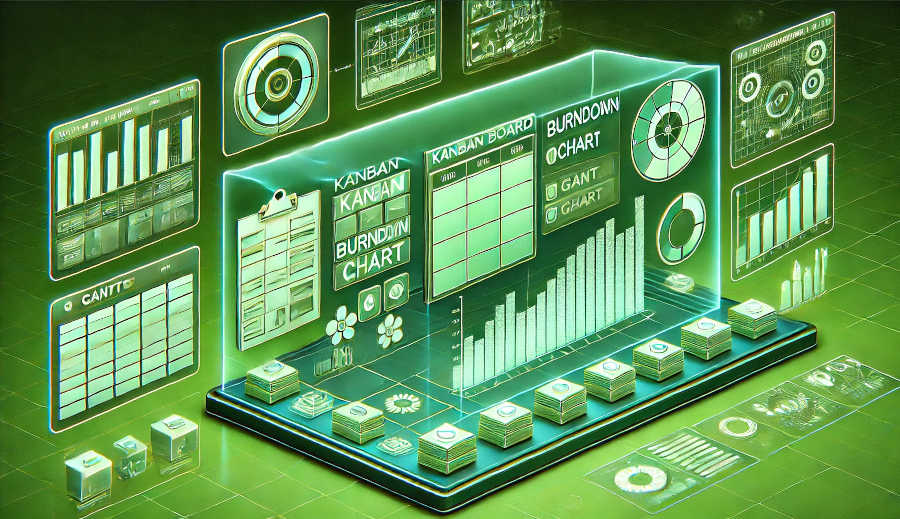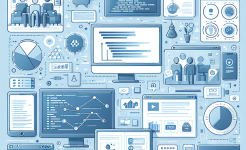Kanban Boards
Kanban boards are visual tools that provide a clear overview of the workflow. They typically consist of columns representing different stages of a project, such as "To Do," "In Progress," and "Done," and cards that represent individual tasks. By using a Kanban board, teams can easily track the progress of tasks, identify bottlenecks, and prioritize work. This transparency helps in maintaining a smooth flow of work during sprints and iterations.
One of the key benefits of Kanban boards is that they promote continuous improvement. As teams work through tasks, they can analyze the flow of work and identify areas where the process can be optimized. For example, if a particular column is consistently overloaded, it may indicate a need to adjust the capacity or reallocate resources. Kanban boards also encourage communication and collaboration within the team, as everyone can see the status of the project at a glance and contribute to resolving any issues.
Moreover, Kanban boards can be easily customized to fit the specific needs of a project or team. Different colors, labels, and tags can be used to categorize tasks, making it easier to filter and search for specific information. This flexibility allows teams to adapt the tool to their unique working style and requirements, ensuring maximum efficiency during agile sprints and iterations.
Scrum Tools
Scrum is a popular agile framework, and there are several tools available that are specifically designed to support Scrum practices. These tools typically include features such as sprint planning, backlog management, and burndown charts. They help teams manage their sprints effectively, track progress, and make informed decisions.
Sprint planning is a crucial part of the Scrum process, and Scrum tools provide a structured way to plan and organize sprints. Teams can define the goals, tasks, and timelines for each sprint, ensuring that everyone is on the same page. Backlog management features allow teams to prioritize and manage the product backlog, which is a list of all the features, enhancements, and bug fixes that need to be completed. By using these tools, teams can ensure that the most important tasks are addressed first, maximizing the value delivered during each sprint.
Burndown charts are another important feature of Scrum tools. They provide a visual representation of the progress of a sprint, showing how much work remains to be done over time. This helps teams monitor their progress, identify any potential issues early on, and make adjustments as needed. Scrum tools also often include reporting and analytics features, which allow teams to analyze their performance over multiple sprints and identify areas for improvement.
Version Control Systems
Version control systems are essential for managing the codebase in software development projects. They allow teams to track changes to the code, collaborate effectively, and revert to previous versions if needed. Git is one of the most popular version control systems, and it is widely used in agile development environments.
With a version control system like Git, teams can work on different branches of the code simultaneously. This enables parallel development, allowing multiple team members to work on different features or bug fixes without interfering with each other. When the work is complete, the branches can be merged back into the main codebase. Version control systems also provide a detailed history of all the changes made to the code, making it easy to track who made what changes and when.
In addition to code management, version control systems also support collaboration. Team members can easily share their code, review each other's work, and provide feedback. This helps in ensuring the quality of the code and promotes knowledge sharing within the team. Version control systems also integrate well with other development tools, such as integrated development environments (IDEs), making it seamless for developers to manage their code during agile sprints and iterations.

Continuous Integration and Continuous Delivery (CI/CD) Tools
Continuous integration and continuous delivery (CI/CD) tools automate the process of building, testing, and deploying software. They help teams deliver high-quality software more frequently and reliably, reducing the time and effort required for manual processes. Tools like Jenkins, GitLab CI/CD, and Travis CI are popular choices for implementing CI/CD pipelines.
CI/CD tools work by automatically building the code whenever a change is made to the version control system. They then run a series of tests to ensure that the code is functional and meets the required quality standards. If the tests pass, the code can be automatically deployed to a staging or production environment. This continuous feedback loop helps in catching bugs and issues early in the development process, reducing the risk of costly mistakes and delays.
By automating the build, test, and deployment processes, CI/CD tools also improve the efficiency of the development team. Developers can focus on writing code, knowing that the tool will take care of the rest. This allows for faster development cycles and more frequent releases, enabling teams to respond quickly to customer needs and market changes during agile sprints and iterations.
Collaboration Tools
Effective collaboration is crucial for the success of agile teams. Collaboration tools such as Slack, Microsoft Teams, and Zoom provide a platform for team members to communicate, share information, and collaborate in real-time. These tools support various forms of communication, including text messaging, voice calls, and video conferencing.
Slack, for example, allows teams to create channels for different projects, topics, or teams. Team members can join these channels to discuss specific issues, share files, and receive notifications. The search functionality makes it easy to find past conversations and information. Microsoft Teams offers similar features, along with integration with other Microsoft Office applications, making it convenient for teams that already use the Microsoft ecosystem.
Video conferencing tools like Zoom are especially useful for remote teams. They enable face-to-face communication, which is essential for building relationships and resolving complex issues. Collaboration tools also often include features such as screen sharing, which allows team members to share their desktops and present ideas or solutions. By using these tools, teams can stay connected and collaborate effectively, regardless of their physical location, during agile sprints and iterations.
Project Management Software
Project management software provides a comprehensive platform for managing all aspects of a project, including tasks, resources, timelines, and budgets. Tools like Jira, Trello, and Asana are widely used in agile development projects to help teams plan, track, and manage their work.
Jira, for example, offers a wide range of features for agile project management. It allows teams to create and manage issues, assign tasks to team members, and track the progress of each task. Jira also provides powerful reporting and analytics features, which can be used to monitor the performance of the team, identify trends, and make data-driven decisions. Trello, on the other hand, is a more lightweight and visual project management tool, similar to a Kanban board. It is easy to use and can be customized to fit the needs of different teams.
Asana is another popular project management tool that offers features such as task management, project planning, and team collaboration. It allows teams to set up projects, create tasks, and assign due dates. Asana also provides integration with other tools, making it easy to connect with existing workflows. By using project management software, teams can ensure that all aspects of the project are well-organized and managed, leading to more successful agile sprints and iterations.
In conclusion, the right tools can play a crucial role in the success of agile sprint and iteration. Kanban boards provide visual transparency and promote continuous improvement, while Scrum tools support the implementation of Scrum practices. Version control systems enable effective code management and collaboration, and CI/CD tools automate the build, test, and deployment processes. Collaboration tools facilitate communication and teamwork, and project management software helps in organizing and managing all aspects of the project. By carefully selecting and using these tools, teams can enhance their efficiency, productivity, and the quality of the products they deliver. It is important for teams to evaluate their specific needs and choose the tools that best fit their working style and requirements. With the right combination of tools, agile teams can thrive and achieve their goals in a dynamic and competitive environment. As the field of agile development continues to evolve, it is essential for teams to stay updated with the latest tools and technologies to ensure they are able to adapt and succeed in the ever-changing landscape. By leveraging these six tool recommendations, teams can set themselves up for success in their agile sprint and iteration processes, delivering value to their customers more effectively and efficiently.
ARTICLE TITLE :6 tool recommendations for agile sprint and iteration ,AUTHOR :ITpmlib

















